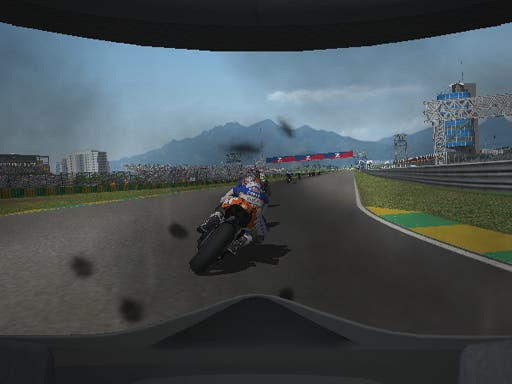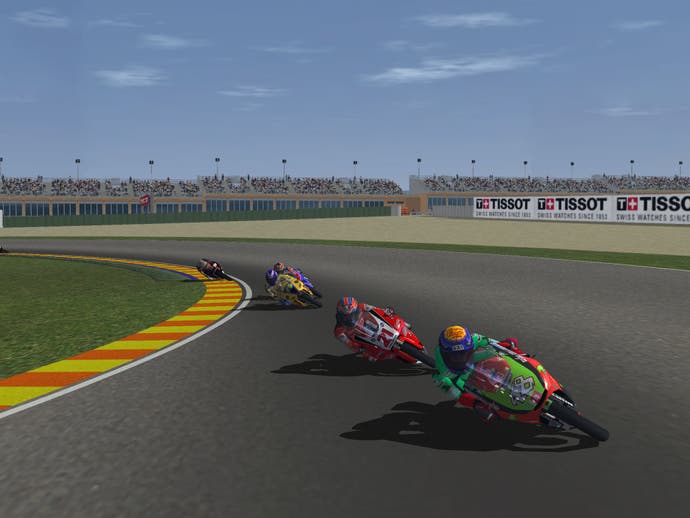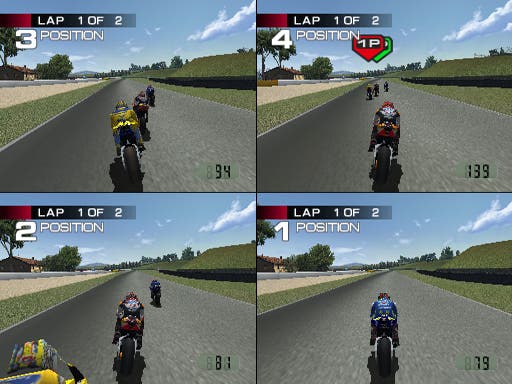MotoGP 4
More road re-hash than road rash.
Given that the stock of racing games has never been higher than it is right now, you'd think there would be more of a fuss surrounding the release of the PS2's premier motorcycle racing game. But with every passing year, Namco churns out another MotoGP and very few racing game fans care. Even a little bit. And you know why? Because, for reasons we'll hopefully explore in a few paragraph's time, they're simply not all that exciting to play.
(Unlike Climax and THQ's Xbox/PC series, helpfully also called MotoGP, which usually reviews very well. Just to clear that one up early on.)
As with all the entirely unnecessary annual updates that pepper the gaming scene, MotoGP 4 instantly becomes another one of those games where you're forced to get the electron microscope out and play spot the difference. This year's update, though, promises quite an impressive list of additions that ought to make it interesting to the growing band of real-life MotoGP followers at the very least - but will the rest of us care?
Welcome to the party, pal
The fourth MotoGP in just over three years has finally included 125cc and 250cc classes, as well as the useful addition of a training mode for the first time. As relative novices to the scene, we have to ask, though, why weren't these included in the first place?
As with all officially licensed titles, the full roster of 16 tracks, updated teams, riders and their hot, throbbing, mean machines make it into the package - but that's been the case ever since the series first roared onto the tracks way back when. Why would any gamer want to buy this when there are cheaper incarnations of the same franchise already available to buy, not to mention several iterations in the vastly superior Climax-developed Xbox/PC series? The answer is they wouldn't. It's a pretty easy and predictable conclusion to come to within minutes of playing Namco's effort, especially if you own both systems.
The addition of the two less powerful bike classes certainly makes the learning curve less daunting than it ever has been previously. The handling, for instance, is far easier to judge on a slower machine and it's much easier to work your way up the pack without having to have a prior knowledge of the track, and the AI is noticeably less tough.
Class act

The new classes have also beefed up the career mode in a distinct way that will give long-term fans a deeper challenge than ever before. As usual you can race an entire season as one of MotoGP's current big names (or one of the legends such as Kevin Schwantz, Wayne Rainey, Mick Doohan, Wayne Gardner or even the late Daijiro Kato), but the key addition is the ability to work your way right from the bottom rung of the ladder with a custom rider from 125cc and up. Along the way you can upgrade your ride and get a real sense of hard-won progression as you make it into the big-time. For the novice, this all seems a bit daunting, but for the hardcore fan it's without doubt the most significant addition to the game.
Luckily, for the novice there's the addition of the training mode to ease you into the proceedings in a manner not dissimilar to the Gran Turismo license tests. The fog of learning handling tricks is blown away, and racing tactics are explained in some depth. Although most of this will seem utterly superfluous to those used to the series, it's a well-judged addition that will hopefully encourage one or two outsiders to take the plunge.
Indeed, with the simulation mode turned off, it's surprisingly easy to pick up and play. Roaring hell-for-leather down the track at full speed doesn't send you into the gravel on the first corner, and you're pretty much allowed to take as many crazy risks as you want without too much in the way of penalty for doing so. Select one of the easier skill levels, let the AI assist your braking and over a five-lap race you'll almost certainly cream the opposition without breaking a sweat. Hardly challenging, but a good sign that Namco is at least trying to make the game a more accessible affair to newcomers.
Full throttle

Of course, in Simulation mode it's like an entirely different game altogether. Misjudge the throttle and you'll be all over the place. Lean too far into the corners and you'll be thrown violently off your ride. With even independent front and rear brakes to take into account, it's a game you really have to work hard to master. For the casual racing fan it's a real culture shock to have to work so hard to even stay on the track.
But in whatever mode you choose to play in, the handling can't disguise some sloppy collision detection that makes bumps and crashes with other riders look - and feel - particularly unconvincing. In addition, the longer you play it, the more the CPU AI just feels flawed. If you manage to nudge your way to the front of the pack, trailing riders have an alarming tendency to bump their way past you with bizarre burst of speed and scant regard for their or your safety, only to settle back down into a rhythm that makes it possible for you to return the favour. And so on. Repeat to fade. Couple that with the silly collision effects and MotoGP 4 soon ceases to feel as convincing as the handling initially suggests.
Elsewhere there are a bunch of other less intensive filler modes to work your way through. The good old Arcade mode simply lets you get in some much-needed practice for the main dish, allowing you to set up whatever race you fancy, Time Attack offers exactly what you'd expect it to, and the expanded Challenge mode offers 100 specific tasks to overcome; from beating specific riders to more track-based challenges. None of them serve as more than a means of offering some extra pick up and play action, but are welcome nonetheless - especially if you're keen to earn points and set about unlocking all the hidden extras.
A rush and a push and the LAN is ours

The most obvious disappointment is the baffling lack of online play - especially when you take into account that the nigh-on two-year-old MotoGP 2 on Xbox had this feature, and the soon-to-be released third version is less than two months away. There is a minor concession to multiplayer antics with the presence of an eight-player LAN mode, but the practicalities involved in setting such a match up dictate that the chances of this happening are virtually nil for most PS2 owners. With that scrubbed out of the equation, this leaves four-player split-screen racing to fall back on. It's not an ideal situation for PS2 owners at this stage in the console's lifespan, especially once you notice the frame rate and detail dip that comes with it.
Talking of the visuals, this all-important side of the game is the one area that Namco could have really polished up to new heights. It's fair to say that previous MotoGPs have never really set the PS2 on fire in the way that, say, Burnout manages with some style, and this year's model will leave most gamers pretty cold in terms of the wow factor. Without exception, tracks veer dangerously close to being dull, and although the detail levels have been upped a notch, it comes at a price. Predictably, that price comes in the form of frame-rate dips, and, considering how bland the texturing is, you'll be scratching your head trying to figure out why. The addition of a new helmet-cam viewpoint offers a different view on the proceedings, but it's not exactly one you'll consider employing for very long - unless you want to find out what it's like to scrape your face along the tarmac.
Actually, embedding gravel into your face will be a considerably more pleasurable way of passing your gaming time than having to put up with MotoGP 4's music. In a way that only Japanese-developed racing titles seem proficient with, the soundtrack is the aural equivalent of being locked in a room filled with double glazing salesmen, accountants, insurance reps, second-hand car dealers and David Icke. For a year. Someone make the pain end before innocent people get hurt. Call Hillary Clinton. Call Jack Thompson. Take affirmative action.
Skip to the end

Apparently the bikes sound like, you know, real bikes. But don't ask us. We board exploding trains and drive like crazy men in our own little re-enactment of those bollard dodging moments in The Getaway. Can you tell we're desperate to reach the concluding paragraph yet?
We thought we'd never get here. By now you might have got the sense that MotoGP 4 has plenty of earnest intentions, but it'll be entirely lost on the majority of its potential audience. The main overriding problem (badum) is the same as ever: the sense of excitement, speed, and - above all - fun just isn't as strong as the four-wheeled racers busy hogging the upper echelons of the world's charts. Namco can throw in as many tracks, riders and modes as it likes, but it'll have to go a lot further to improve the actual racing experience before we're ready to consider donning our leathers and getting out there on the tarmac again. Good intentions or not, MotoGP's for the hardcore. Again.

